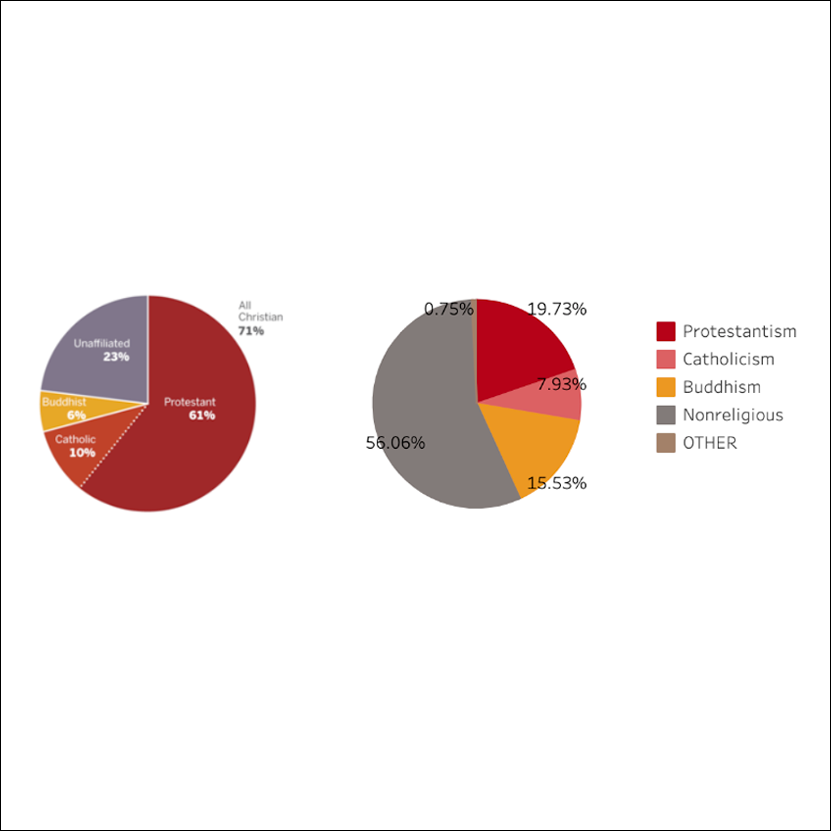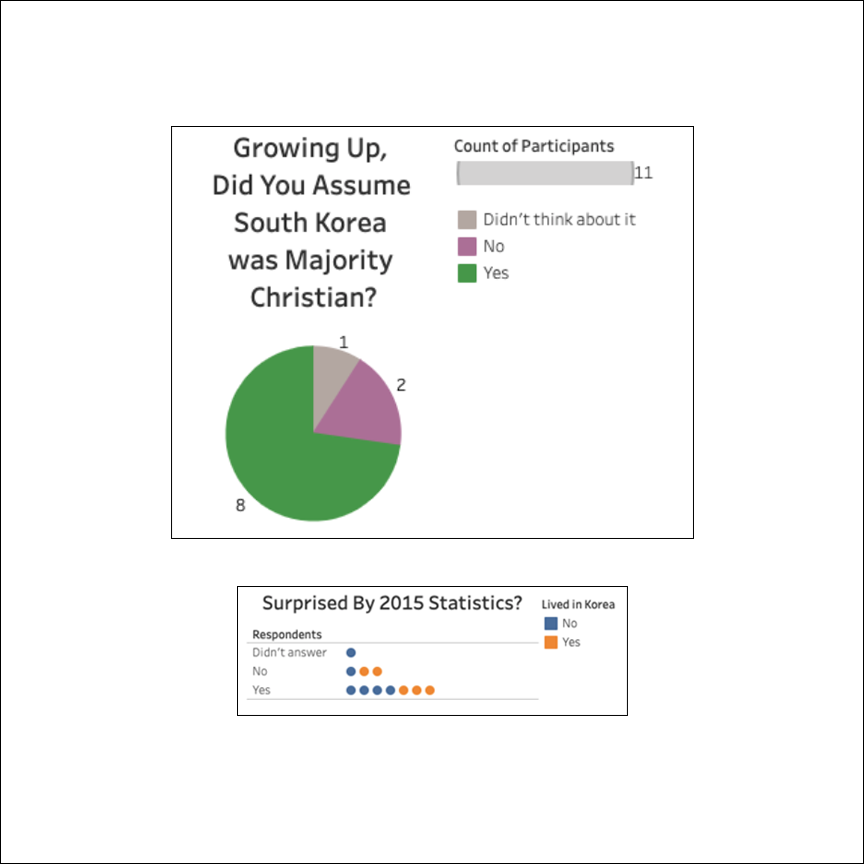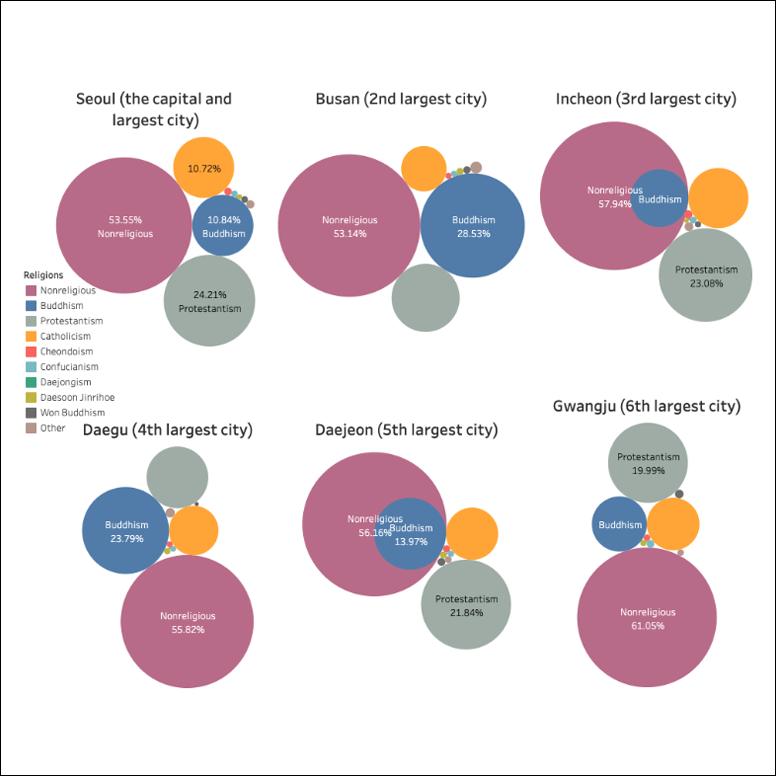South Korea’s Religious Breakdown vs. Korean Americans in the US

Korean Americans' religious makeup (left) contrasts significantly against South Koreans' with 71% identifying themselves as Christian in the US vs. 28% (Protestant and Catholic combined) in South Korea.

Eight of the 11 participants - all of whom were ethnic Koreans who grew up outside of Korea - said they'd assumed that most South Koreans were Christians. Seven said they were surprised by the statistics, three said they were not, and one didn’t answer.

Different cities in Korea have different proportions of religious affiliations. For example, in contrast to Seoul, in Busan, there are more than twice the amount of Buddhists (almost 29% or 958,683 people) than Protestants (12% or 407,659 people). The fourth largest city of Daegu also has almost double the amount of Buddhists (almost 24% or 571,511 people) compared to Protestants (12% or 288,540 people).
(For the full report, please click here.)
Executive Summary
South Korea is a country with no official religion, and there is no religion considered to be the country’s dominant one (Kim, 2002). However, when you’re an ethnic Korean growing up outside of the homeland, this may not be obvious to you.
I myself grew up in Atlanta beginning in the early ’80s within a very Christian Korean-American community. I attended a Korean Methodist church every Sunday, but when I was around 13 or 14 years old, I – along with my two older brothers – started refusing to go to church because we knew in our hearts that we did not actually believe in the religion. Starting around that time, I pondered a lot about how – aside from my brothers – I had never met another Korean American who was not Christian even by the time I was in college in the early 2000s. I thought this was peculiar as I’d become aware of South Korea’s Buddhist history. I even asked my parents directly what the religious breakdown was back in the homeland, and they claimed that it was mostly Christian. However, when I moved to South Korea in 2007 and over the next five years that I lived there, I learned that this was far from true.
For years I’ve watched both ethnic Korean and non-Korean friends mistakenly assume that South Korea is a majority Christian country. I’ve seen ethnic Korean celebrities such as the drag performer Sang-Young Shin aka Kim Chi from “RuPaul’s Drag Race” season eight and Eugene Lee Yang of “The Try Guys” – in a conversation with each other – erroneously claim that Korea is mostly Christian (around 1:05) in a video that’s gotten over three-and-half million views. Shin says, “The entire country of Korea is, like, very religious and conservative, right?” and Eugene answers, “Yeah. I was Presbyterian growing up,” And Sang says, “Were you? Me, too!”
As a result, I wanted to illustrate the true data with visualizations. I also wanted to survey ethnic Korean friends who grew up outside of Korea and visualize their assumptions about South Korea’s religious breakdown.
Results
The Korean government data shows that 56% of the population of nearly 50 million actually identifies as “nonreligious” while just under 44% consider themselves “religious.” Nationally, Christianity makes up only around 28% of the population (with Protestantism at almost 20% and Catholicism at almost 8%), Buddhism just under 16%, and less than 1% is made up of the minority religions of Won Buddhism, Confucianism, Cheondoism, Daesoon Jinrihoe, Daejongism, and “Other.” However, there are differences by city; for example, while the capital and largest city of Seoul has more Protestants than Buddhists, the second largest city of Busan has more Buddhists than Protestants.
According to Pew Research Center, in the US, Korean Americans are 61% Protestant, 10% Catholic, 6% Buddhist, and 23% say they have no particular religious affiliation. This contrasts significantly against South Korea’s figures. The substantially larger proportion of Korean Christians found in the US may explain why I mistakenly believed South Korea to be majority Christian while growing up and why I keep meeting other ethnic Koreans who incorrectly believe this to this day.
Also, of the 11 ethnically Korean friends I surveyed for this project, most of them assumed South Korea was majority Christian. Most of them were also surprised by South Korea’s actual religious statistics. Interestingly, three out of the five respondents had actually lived in Korea for between two and five years each, and they still incorrectly thought the population was majority Christian even after returning to North America. This misperception may partly be due to the fact that all the respondents who lived in Korea lived in Seoul, which has the highest proportion of Christians in the country at almost 35% with 24% being Protestant and 11% Catholic.
Tools Used
Programming languages: R
OpenRefine (for data cleaning)
Tableau (to create maps, treemaps, pie charts, dot plots, and bubble charts)
Method
1) Finding data on South Korea’s religious statistics
For South Korea’s religious statistics, I used the most recent Korean government official statistics (from 2015). I translated the spreadsheet into English and transformed the rows into columns in order to configure the CSV file for use in Tableau Public, a free software for creating interactive graphs, maps, and live dashboards using a variety of formats, including CSV, Excel, and Google Sheets.
2) Survey of ethnic Korean friends’ perceptions of South Korea’s religious breakdown
For this project, I surveyed 11 ethnic Korean friends, nine of whom grew up in North America, one in Fiji, and one in Indonesia. Now, nine live in the US, one in Canada, and one in Sweden.
3) UX research
To carry out UX research while finalizing my visualizations, I asked one friend who’s a modern Korean history professor and another friend who’s a PhD candidate studying an endangered regional dialect of Jeju Island, South Korea, about my visualizations. I gave the context of this report and asked whether they made sense and if they had any critiques, suggestions, and observations overall.
One asked questions about my Tableau dashboards that I found to be peculiar as I looked them over on my desktop computer, which is when we both realized she was viewing them on a mobile device. I hadn’t known previously – and learned in that moment – that Tableau auto-generates a mobile layout for each dashboard, which can look quite disastrous if the author doesn’t configure everything into a cohesive narrative. So I fixed the mobile versions of the dashboards after that.
The other friend recommended that I make a pie chart to compare to the Pew Research Center’s “Korean Americans” one (Fig. 1), which I did not initially have and thought was a good idea.

